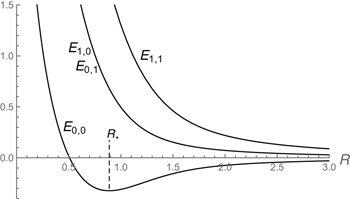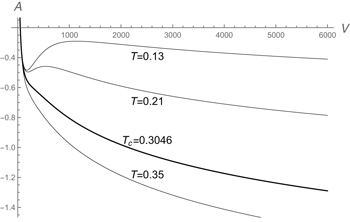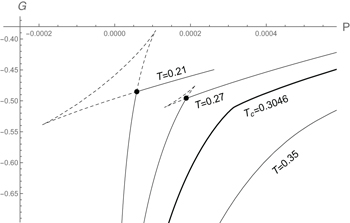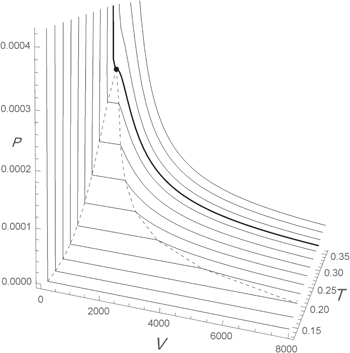Abstract
A gas-liquid type of phase transition is found based on the particle dynamics on a radius-R circle in which the coordinate appears as the angle-variable of the 1D XY-model. Due to the specific appearance of a compact-space radius (volume) in the present interpretation of the XY-model, the ground state develops a minimum at some critical radius, leading to the multi-valued Gibbs energy similar to systems with first-order phase transition.
Export citation and abstract BibTeX RIS
Introduction
The absence of phase transition in one-dimensional models of magnetic systems is commonly considered as a special case of the so-called van Hove's theorem [1]. However, a detailed examination of conditions by the theorem shows that even 1D models may exhibit phase transitions [2].
In the present note a model is considered for particle dynamics based on the 1D XY-model of magnetic systems. The model was initially considered in [3], with emphasis on the phase structure due to the model's defining parameter. In the present work the main concern is the first-order phase transition based on the PV equation of state by the model, qualitatively similar to the gas-liquid phase transition for systems with for example van der Waals equation of state [4]. In the proposed dynamics, the coordinates are assumed to be compact variables of radius-R circles, appearing as angle-variables of 1D XY-models living on the particle's discrete worldline. The present approach to particle dynamics is similar to the one in lattice formulation of gauge theories, in which the gauge variables appear as compact angle variables living on a discrete lattice. As will be discussed in detail, due to the specific appearance of the radius in the formulation, the ground-state energy develops a minimum at some critical radius, leading to the multi-valued Gibbs energy quite similar to the systems with gas-liquid first-order phase transition.
The organization of the rest of the paper is as follows. In the next section the model for particle dynamics as well as its exact spectrum and the emergence of a minimum in the ground state are presented. In the third section the thermodynamics and the phase structure by the model are presented. It is discussed how the minimum in the ground state leads to the PV and GP diagrams similar to those of gas-liquid systems. In the fourth section a detailed comparison is made between the present and the magnetic interpretations of the XY-model. In particular, the distinguished role by the compact space radius in the announced first-order phase transition is clarified. The fifth section is devoted to concluding remarks and possible extensions of the present model.
The model and its spectrum
In this section the model and its exact spectrum are presented. However, it is useful to review the basic elements of the thermodynamics by the ordinary dynamics. It is known that the ordinary dynamics of free particles does not lead to a phase transition. In particular, the one-particle partition function at temperature  for a particle of mass m in a d-dimensional box of volume
for a particle of mass m in a d-dimensional box of volume  is given by [5]
is given by [5]

in which S0 is the imaginary-time action in the time-sliced form

with  as the tiny time-slice parameter. The representation (1) is to be supplemented by the periodic condition
as the tiny time-slice parameter. The representation (1) is to be supplemented by the periodic condition  (in the continuous-time form
(in the continuous-time form  ). In the L → ∞ limit (1) reduces to the well-known expression [4]
). In the L → ∞ limit (1) reduces to the well-known expression [4]

By means of the free-energy  , the equation of state
, the equation of state  leads to
leads to  , by which one expects the thermodynamics of a single-phase ideal gas.
, by which one expects the thermodynamics of a single-phase ideal gas.
In the present work the particle dynamics based on the 1D XY-model is again introduced by the imaginary-time action, in which instead of the action (2), we consider (in units  )
)

in which "a" appears as the spacing parameter on the discrete worldline. The coordinate xi is treated as compact angle-variable for which we assume

As mentioned earlier, the treatment of coordinates as angle variables may be considered as the continuation of the agenda originated by lattice formulation of gauge theories, in which the gauge fields act as angle variables [6,7]. The action (4) is in fact the sum of d copies of 1D XY-model, for which it is known there is no phase transition as a magnetic system [8]. As will be clarified later, it is the specific appearance of the volume of compact space in the present interpretation, namely the presence of radius R both inside and in front of the cosine functions in (4), which leads to the announced phase transition.
The action (4) reduces to the ordinary one (2) in the limit  . Using the transfer-matrix method one can obtain the energy spectrum by the imaginary-time (Euclidean) action. The element of the transfer matrix
. Using the transfer-matrix method one can obtain the energy spectrum by the imaginary-time (Euclidean) action. The element of the transfer matrix  between two adjacent times n and n + 1 is given in terms of the imaginary-time action [5]
between two adjacent times n and n + 1 is given in terms of the imaginary-time action [5]

In the Fourier basis  , it is easy to see that the above transfer matrix is diagonal [3,8]. Using the relation
, it is easy to see that the above transfer matrix is diagonal [3,8]. Using the relation  with
with  as the Hamiltonian, one finds the exact energy spectrum [3,8]
as the Hamiltonian, one finds the exact energy spectrum [3,8]

in which si's are integers, and Is is the modified Bessel function. In fact the expression for the spectrum of the XY-model of magnetic systems is essentially as above [8], except for the extra square root  , by which a key minimum is developed in the ground state
, by which a key minimum is developed in the ground state  at radius (see fig. 1)
at radius (see fig. 1)

The minimum in the ground state is an indication that the system exhibits a first-order phase transition, as we will see later.
Fig. 1: The plots of the three lowest energies in units  for the d = 2 case. The ground state's minimum is at
for the d = 2 case. The ground state's minimum is at  .
.
Download figure:
Standard imageThe limiting behaviors of the spectrum can be obtained. At the extreme large radius limit  , using
, using  for
for  , one finds the almost continuous spectrum
, one finds the almost continuous spectrum

as the ordinary kinetic energy of a free particle moving with momentum  in the compact direction with radius R. In the small radius limit
in the compact direction with radius R. In the small radius limit  , using
, using  for
for  , we find for the discrete spectrum
, we find for the discrete spectrum

So the continuous spectrum in the large radius limit approaches the discrete one in the small radius limit.
Partition function and phase transition
The partition function may be evaluated either by the definition

or by means of the representation similar to (1) [5]

supplemented by the periodic condition  . In the present case the equivalence of (11) and (12) is checked numerically. By either (11) or (12) it is easy to see that
. In the present case the equivalence of (11) and (12) is checked numerically. By either (11) or (12) it is easy to see that

simply because the action (4) is fully separable in xi's. By means of the free energy  , the partition function (11) can be used to study the phase structure by the model. Hereafter we work with the choice
, the partition function (11) can be used to study the phase structure by the model. Hereafter we work with the choice  , and consider the case d = 3, in which the volume and radius are related as
, and consider the case d = 3, in which the volume and radius are related as  or
or  . As a consequence of the mentioned minimum in the ground state at radius
. As a consequence of the mentioned minimum in the ground state at radius  , at sufficiently low temperatures where the ground state makes a considerable contribution to Z, there are points with common tangents (slopes) in the isothermal AV diagrams. In fig. 2 the isothermal AV diagrams clearly confirm this expectation below the critical temperature
, at sufficiently low temperatures where the ground state makes a considerable contribution to Z, there are points with common tangents (slopes) in the isothermal AV diagrams. In fig. 2 the isothermal AV diagrams clearly confirm this expectation below the critical temperature  . With pressure as slope by
. With pressure as slope by  , in the isothermal PV diagrams there should be different volumes with equal pressure, leading to parts with positive slope
, in the isothermal PV diagrams there should be different volumes with equal pressure, leading to parts with positive slope  . The positive slope in PV diagrams would mean a negative compressibility, leading to the mechanical instability of the system [4]. The mentioned behaviors are similar to those by the van der Waals equation of state, commonly used to describe the systems with gas-liquid transition [4,9]. In the real situation, the system has a constant pressure during the gas-liquid transition, the so-called vapor pressure [4,9]. To reflect the real situation, the PV diagrams are to be modified based on the so-called Maxwell construction [4,9], by which the constant pressure part finds a thermodynamical basis. To maintain the stability of the system at equilibrium, a proper treatment of the part with positive
. The positive slope in PV diagrams would mean a negative compressibility, leading to the mechanical instability of the system [4]. The mentioned behaviors are similar to those by the van der Waals equation of state, commonly used to describe the systems with gas-liquid transition [4,9]. In the real situation, the system has a constant pressure during the gas-liquid transition, the so-called vapor pressure [4,9]. To reflect the real situation, the PV diagrams are to be modified based on the so-called Maxwell construction [4,9], by which the constant pressure part finds a thermodynamical basis. To maintain the stability of the system at equilibrium, a proper treatment of the part with positive  is essential.
is essential.
Fig. 2: The isothermal AV diagrams for d = 3 (temperature units  ). The diagrams with
). The diagrams with  consist of a part in which there are points with common tangents (slopes), leading to equal pressures.
consist of a part in which there are points with common tangents (slopes), leading to equal pressures.
Download figure:
Standard imageIn fig. 3 samples of PV diagrams by the present model are plotted, in which both unmodified paths (dashed lines) and modified ones are present. The Maxwell construction and the corresponding phase structure are best described based on the Gibbs energy  . As a consequence of the mentioned behavior of free energy, the isothermal GP diagrams develop cusps below Tc [4,9], after which G is multi-valued for some pressures. For the present model plots of the isothermal GP diagrams are presented in fig. 4, in which the expected cusps are evident. As for states with equal temperature and pressure, the state with lower G is selected by the system [4], the parts beyond the cusps are not followed by the system. Instead, as volume is changed the constant pressure at the cusp is held during a phase transition. In fig. 4 the dots at the cusps indicate the constant vapor pressure values, and each dashed part in fig. 3 corresponds to a similar part in fig. 4, both not being followed by the system.
. As a consequence of the mentioned behavior of free energy, the isothermal GP diagrams develop cusps below Tc [4,9], after which G is multi-valued for some pressures. For the present model plots of the isothermal GP diagrams are presented in fig. 4, in which the expected cusps are evident. As for states with equal temperature and pressure, the state with lower G is selected by the system [4], the parts beyond the cusps are not followed by the system. Instead, as volume is changed the constant pressure at the cusp is held during a phase transition. In fig. 4 the dots at the cusps indicate the constant vapor pressure values, and each dashed part in fig. 3 corresponds to a similar part in fig. 4, both not being followed by the system.
Fig. 3: The isothermal PV diagrams at different temperatures. The dashed parts represent the diagrams before the modification by the Maxwell construction.
Download figure:
Standard imageFig. 4: The isothermal GP diagrams. The dashed lines represent the parts that are not being followed by system, leading to jump in the slope at the cusp.
Download figure:
Standard imageAs at the cusp there is a jump in the first derivative  , the corresponding transition is categorized as a first-order phase transition [4,9]. The PVT surface for the present model is presented in fig. 5, which is quite reminiscent of the one of a system with the gas-liquid phase transition [4].
, the corresponding transition is categorized as a first-order phase transition [4,9]. The PVT surface for the present model is presented in fig. 5, which is quite reminiscent of the one of a system with the gas-liquid phase transition [4].
Fig. 5: The PVT surface of states for d = 3. The thick curve is at critical temperature  , with the critical point (black dot) coordinates
, with the critical point (black dot) coordinates  and
and  .
.
Download figure:
Standard imageThe origin of the minimum in ground state
The 1D XY-model of magnetic systems is well known to exhibit no phase transition. As in the present interpretation the system is reduced to d copies of a 1D model, it is necessary to understand the origin of the phase transition by the present interpretation of the model. The 1D XY-model of magnetic systems is given by the Hamiltonian

with J as the coupling constant, and  as the orientation of the n-th classical spin on the 1D chain. The partition function for the magnetic system at temperature
as the orientation of the n-th classical spin on the 1D chain. The partition function for the magnetic system at temperature  is then given by [8]
is then given by [8]

Now the key point is that in the magnetic interpretation of the model the coupling J is absent inside the cosine functions of (14) and (15), in contrast to the situation in the particle dynamics interpretation, in which the radius R appears both in front of and inside the cosine functions of (4) and (12). The way of appearance of radius R makes the fundamental difference between two interpretations of the 1D XY-model. In the particle dynamics interpretation one may get rid of R inside the cosine function by defining the angle variables  with
with  . However, this does not remove R's completely, as they would rise in the integral measure of (12), explicitly as
. However, this does not remove R's completely, as they would rise in the integral measure of (12), explicitly as

by which the different appearance of R in comparison with J in (15) is observed. Concerning the energy spectrum, as mentioned earlier it is easy to check that the presence of  in energy (7) is responsible for the minimum in the ground state. This extra appearance of R does not have an analog for J in the spectrum of the 1D magnetic system [8]. Now again, by the new variables
in energy (7) is responsible for the minimum in the ground state. This extra appearance of R does not have an analog for J in the spectrum of the 1D magnetic system [8]. Now again, by the new variables  with the Fourier basis
with the Fourier basis  , using the relation
, using the relation  the radius R comes back as a pre-factor for the transfer matrix (6). In summary, in the particle dynamics interpretation of the XY-model, in contrast to the 1D magnetic system with no phase transition, the specific appearance of the compact space radius (volume) in the model is the origin of the phase transition.
the radius R comes back as a pre-factor for the transfer matrix (6). In summary, in the particle dynamics interpretation of the XY-model, in contrast to the 1D magnetic system with no phase transition, the specific appearance of the compact space radius (volume) in the model is the origin of the phase transition.
Conclusion and discussion
In this letter a particle dynamics interpretation of the XY-model is considered, in which the coordinates are assumed to be compact variables, appearing as angle variables of the 1D XY-model. The present interpretation may be considered as a continuation of the agenda leading to the lattice formulation of gauge theories, in which the gauge fields are assumed to be compact angle variables [6,7]. Accordingly, this leads to the replacement of the action of the quadratic form  by the cosine form
by the cosine form  , with
, with  as the field-flux inside the plaquette P. In the same way, here the quadratic form (2) for the action of a particle is replaced with (4), leading to the mentioned phase structure.
as the field-flux inside the plaquette P. In the same way, here the quadratic form (2) for the action of a particle is replaced with (4), leading to the mentioned phase structure.
In the present interpretation it is clarified that the specific treatment of the dynamics on compact space in the 1D XY-model leads to a first-order phase transition, similar to the PV diagrams of gas-liquid systems. In fact there are examples originated from the 2D magnetic systems that may exhibit a phase transition of the first order. In [10,11] a power form of the interaction terms in the 2D XY and Heisenberg models is considered, leading to a first-order phase transition for sufficiently large power being used. In the present case, however, the first-order phase transition is exhibited by the same power-one cosine term of the 1D XY-model due to the different interpretation.
Apart from the theoretical aspects and implications, one may try to find some applications for the present interpretation, for which the above-mentioned relation with lattice gauge theory may come useful. It is known that the lattice formulation of gauge theories approach the ordinary formulation at the weak coupling limit  , and the behavior at the strong coupling limit is expected to be described by the lattice formulation. In the presented particle dynamics based on the angle variables also the ordinary formulation is recovered at the large radius limit
, and the behavior at the strong coupling limit is expected to be described by the lattice formulation. In the presented particle dynamics based on the angle variables also the ordinary formulation is recovered at the large radius limit  by (8), and the possible relevance of the formulation would appear at the small-R limit. This leads to a possible application of the present model in the cosmological context. In the present cosmological models it is assumed that the matter ingredients obey the ordinary dynamics with the known thermodynamics. It is of interest to see how the dynamics and phase structure by the present model affects the different stages of the Universe during the expansion, through which the system is driven from extremely small sizes to its present extent.
by (8), and the possible relevance of the formulation would appear at the small-R limit. This leads to a possible application of the present model in the cosmological context. In the present cosmological models it is assumed that the matter ingredients obey the ordinary dynamics with the known thermodynamics. It is of interest to see how the dynamics and phase structure by the present model affects the different stages of the Universe during the expansion, through which the system is driven from extremely small sizes to its present extent.
The extensions of the present model to magnetic systems other than the XY-model, such as the Potts model with  -valued spins, can be of interest. In the present work the system obeyed the Maxwell-Boltzmann statistics. The extensions to Fermi-Dirac and Bose-Einstein statistics may lead to interesting features.
-valued spins, can be of interest. In the present work the system obeyed the Maxwell-Boltzmann statistics. The extensions to Fermi-Dirac and Bose-Einstein statistics may lead to interesting features.
Acknowledgments
This work is supported by the Research Council of Alzahra University.










